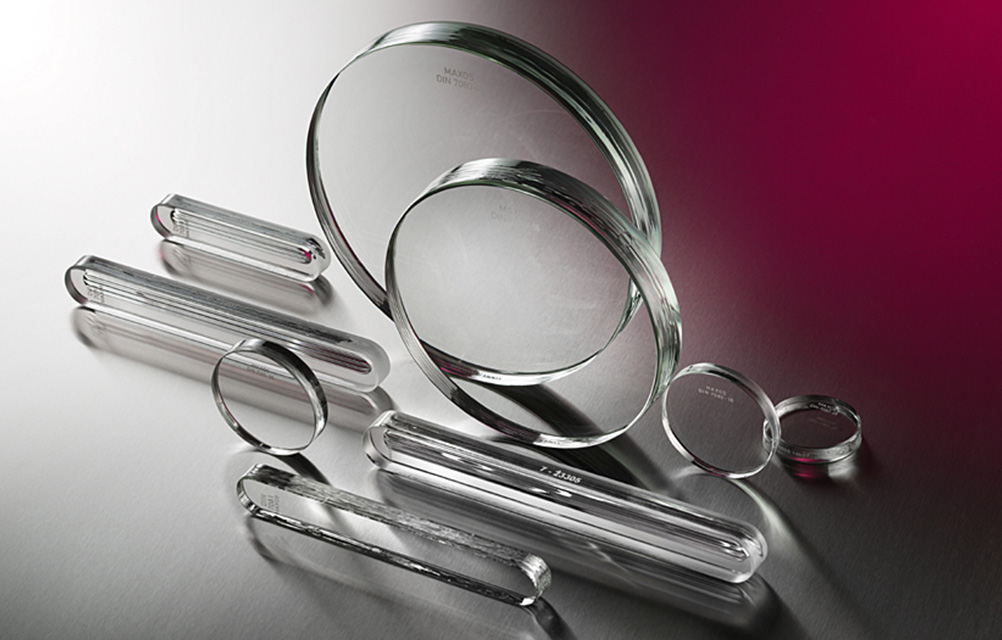MAXOS®
安全視認ガラス及びレベルゲージガラス
MAXOS® safety sight and level gauge glasses made of SUPRAX® 8488 borosilicate glass are perfect for temperatures up to 300 °C. For higher operational temperatures we recommend safety sight and level gauge glasses made of aluminosilicate glass.
The mechanical strength and pressure resistance of MAXOS® safety level gauge glasses depends on many factors: Decisive factors include thermal prestressing, homogeneity of the glass, parallelism, exact dimensions and a flawless surface. At Auer Lighting, a state-of-the-art glass melting process ensures a homogeneous SUPRAX® 8488 borosilicate glass that is nearly free of streaks and bubbles. Through high-quality grinding and polishing processes we achieve particularly flat and plano-parallel surfaces. The prestressing that occurs during thermal tempering is decisive for the strength of the glass.
Auer Lighting ensures all measurement and dimensional tolerances by process-integrated tests. All processing steps can be traced back through encoding on the glass.
Quality and safety are our top priorities. In order to prove this, we can at any time provide corresponding test certificates for our MAXOS® safety sight glasses upon customer request. We prove the conformity according to various industrial standards with test reports 2.2 and inspection certificates 3.1 as per EN 10204. In addition, we can provide our worldwide customers with certificates of food safety, compliance with FDA standards and IHK certificates of origin or individual manufacturer declarations.
Until installation in a fitting, we recommend that the glass be kept in its original packaging. Contact with sharp-edged and rigid materials should be avoided, as should movement of the glass on work bench or other work space. Under certain circumstances, this can lead to damage in the form of scratches. When installing in the sight glass fitting, chips and damage to the chamfers of the sight glass need to be avoided as this can significantly reduce the pressure load.
We use cookies. Some of them are necessary to make the website usable. Others help us display information that is relevant and engaging to you. As data protection is important to us, we ask you to decide on the scope of use. You can either accept all cookies or choose your individual settings. Thanks and enjoy our website!
This is an overview of all cookies used on this website. Please make your individual settings. You can adapt them at any time by using the "Cookie settings" link in the footer of this website.
These cookies are essential to the operation of the website, e.g. by saving your cookie settings.
| Name | alto. Cookie |
|---|---|
| Provider | Provider |
| Purpose | Saves the visitor's settings |
| Identifier | alto-cookie |
| Validity | 1 year |
Tools collecting usage data anonymoulsy, giving insights into how to improve our services for you.
| Accept | |
|---|---|
| Name | Google Analytics |
| Provider | Google LLC |
| Purpose | Google cookie for website analyses. Creates statistical data on website usage. |
| Privacy | https://policies.google.com/privacy |
| Identifier | _ga,_gat,_gid |
| Validity | 2 years |
Tools enhancing the browsing exerience, e.g. maps or videos.
| Accept | |
|---|---|
| Name | YouTube |
| Provider | YouTube, LLC |
| Purpose | Used to unlock Youtube contents. |
| Privacy | https://policies.google.com/privacy |
| Identifier | yt-remote-fast-check-period, yt-remote-session-app, yt-remote-session-name |
| Validity | Session |
| Accept | |
|---|---|
| Name | Google Maps |
| Provider | Google LLC |
| Purpose | Used to unlock Google Maps contents. |
| Privacy | https://policies.google.com/privacy |
| Identifier | NID |
| Validity | 2 Years |
| Accept | |
|---|---|
| Name | Vimeo |
| Provider | Vimeo, LLC |
| Purpose | Used to unlock Vimeo contents. |
| Privacy | https://vimeo.com/privacy |
| Identifier | vuid |
| Validity | 2 Years |